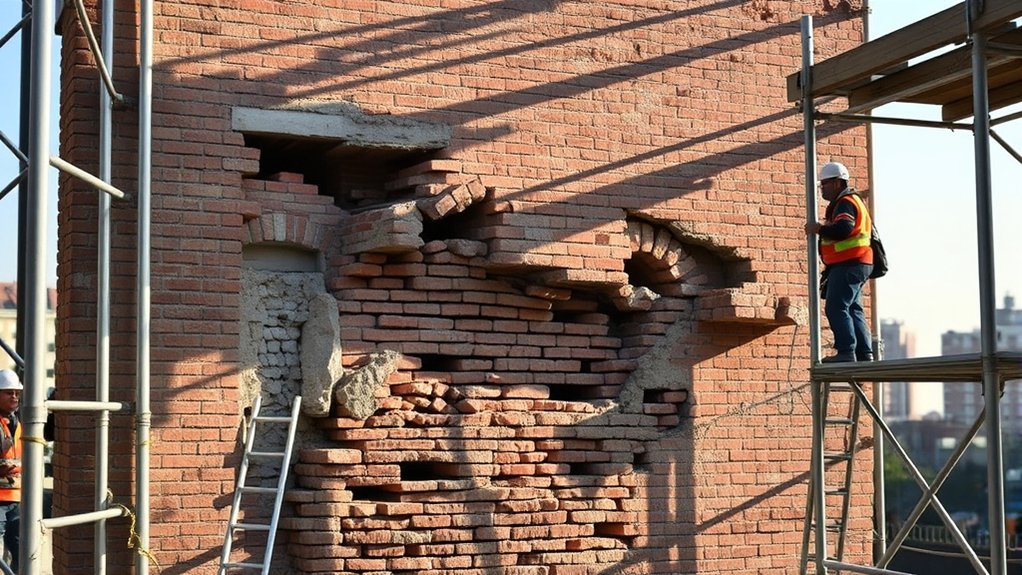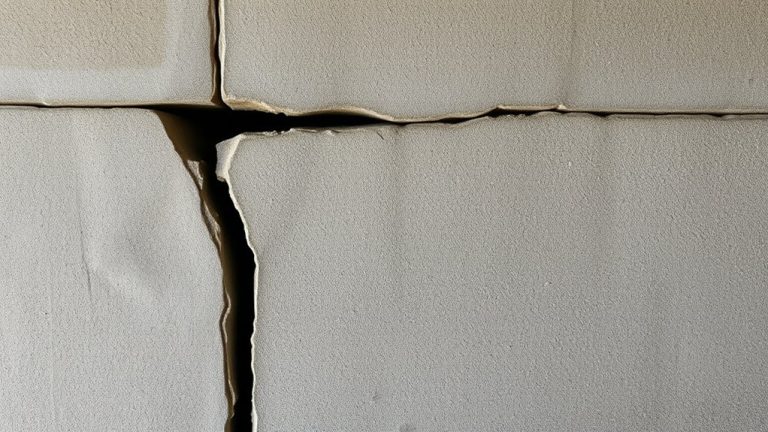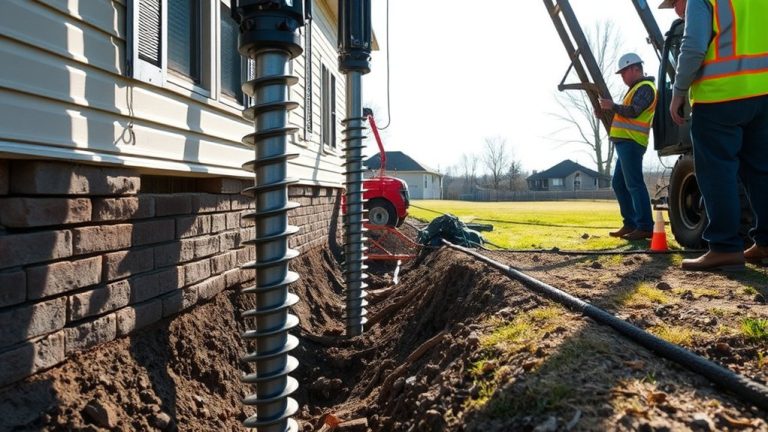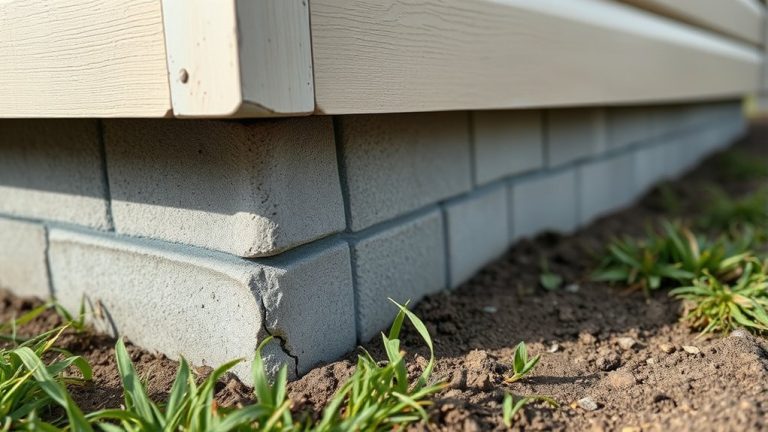When your walls start showing signs of serious damage, you'll want to know if rebuilding is your best option. Cracks, bowing, and water intrusion aren't just cosmetic issues—they're red flags signaling potential structural problems. You might be facing costly repairs or a complete wall reconstruction. But don't panic. Understanding the warning signs and when professional intervention is necessary can save you time, money, and potential safety risks. Curious about what these signs are and how to address them?
Key Takeaways
- Extensive horizontal or diagonal wall cracks wider than 1/4 inch indicate critical structural damage requiring potential rebuilding.
- Severe water damage compromising wall integrity, creating mold environments, and weakening foundational strength necessitates comprehensive wall reconstruction.
- Foundation shifting causing persistent wall stress, uneven ground support, and escalating structural instability demands professional evaluation and potential rebuilding.
- Material degradation showing advanced signs like significant discoloration, multiple surface irregularities, and accumulated microscopic damage signals comprehensive wall replacement.
- Cost-effectiveness analysis comparing repair versus total rebuilding should consider long-term structural integrity, maintenance requirements, and potential future safety risks.
Signs of Structural Wall Damage
When it comes to wall damage, early detection can save you thousands in repair costs. Interior wall cracks and exterior wall crevices are critical warning signs you shouldn't ignore.
These structural indicators might signal deeper problems like foundation shifts, water damage, or age-related wear. Look for horizontal or diagonal cracks wider than 1/4 inch, which often suggest serious structural issues. Bulging, bowing, or uneven surfaces can also point to potential wall failure.
Horizontal foundation cracks can be particularly dangerous and may require immediate professional intervention to prevent further structural damage.
If you notice these signs, don't panic—professional assessment can help you understand the extent of damage and plan necessary repairs before the situation worsens.
Water Damage and Wall Integrity
Wall cracks aren't the only structural threat homeowners face—water damage represents another serious risk to your property's integrity.
When moisture penetrates your walls, it can trigger poor insulation performance and create an ideal environment for mold and mildew growth. You'll want to address water intrusion quickly to prevent long-term structural damage.
Unchecked water exposure can weaken your wall's foundation, compromise its strength, and lead to expensive repairs. By identifying moisture sources early and implementing proper waterproofing techniques, you'll protect your home's structural integrity and maintain a safe, healthy living space. Basement waterproofing experts recommend addressing water intrusion immediately to prevent toxic mold growth and foundation damage.
Foundation Shifting and Wall Stress
Because house foundations naturally settle over time, homeowners often encounter complex structural challenges that can substantially impact wall integrity. Shifting foundations create significant stress on your walls, potentially leading to serious damage.
- Soil compaction can cause uneven ground support
- Weathering effects gradually weaken structural connections
- Minor shifts can escalate to major structural problems
- Professional assessment is vital for early detection
Understanding these essential factors helps you protect your home's structural health and prevent costly repairs. Your proactive approach can save thousands in potential reconstruction expenses.
Material Degradation and Aging Walls
As homes age, their walls inevitably experience material degradation that can compromise structural integrity and aesthetic appeal. Moisture absorption and thermal expansion gradually weaken your walls, causing microscopic damage that accumulates over decades.
You'll notice subtle signs like hairline cracks, slight discoloration, or minor surface irregularities that hint at deeper structural challenges. These changes aren't just cosmetic – they represent potential risks to your home's stability and your personal safety.
Regular inspections can help you catch early warning signs, allowing proactive maintenance before significant deterioration occurs. Understanding these natural aging processes enables you to safeguard your most precious asset: your home.
Understanding Repair vs. Rebuilding Costs
Recognizing the early signs of wall degradation naturally leads homeowners to weigh their repair options against complete rebuilding strategies. Your budgeting considerations will greatly impact your decision-making process.
Consider these key factors:
- Current wall condition and structural integrity
- Time saving techniques for minimal disruption
- Long-term cost-effectiveness of repair versus replacement
- Potential future maintenance requirements
Repairing might seem cheaper initially, but rebuilding could save you money and headaches down the line. You'll want to carefully evaluate the extent of damage, material costs, and labor expenses to make the most informed choice for your home's longevity and your financial freedom.
Professional Assessment and Reconstruction Strategies
When you're facing significant wall damage, seeking a professional assessment becomes your most critical first step toward successful reconstruction. Specialists will perform a thorough structural analysis, examining the extent of damage and potential underlying issues.
They'll evaluate your wall's condition, checking for code compliance and recommending the most effective repair strategies. By bringing in professionals, you'll gain understanding into whether rebuilding is truly necessary or if targeted repairs can solve the problem. Their knowledge helps you make informed decisions, potentially saving you time, money, and future headaches while ensuring your wall's integrity and safety.
Frequently Asked Questions
How Long Does a Typical Wall Rebuilding Project Take to Complete?
You'll need 1-2 weeks for a standard wall rebuild, depending on structural integrity assessment and cost effective renovation options. The timeline varies with complexity, material availability, and your specific project scope.
Can I Live in My Home During Wall Reconstruction?
You'll likely need to arrange temporary accommodations during wall reconstruction. Safety concerns and extensive work might make living in your home challenging, so consider alternative housing options for the project's duration.
Will My Homeowners Insurance Cover Wall Rebuilding Expenses?
Your policy coverage varies, so you'll need to review your specific homeowners insurance details. Contractor costs might be partially covered depending on the wall damage's cause and your policy's terms.
What Are the Most Affordable Wall Rebuilding Material Options?
You'll find cost-effective alternatives like reclaimed wood, recycled concrete, and bamboo that offer sustainable materials with lower expenses and greater design freedom for your wall rebuilding project.
How Disruptive Is a Complete Wall Reconstruction Process?
You'll experience minimal interference with strategic planning. Cost-effective reconstruction methods can reduce downtime, allowing you to manage the process efficiently without sacrificing quality or personal freedom during wall rebuilding.



